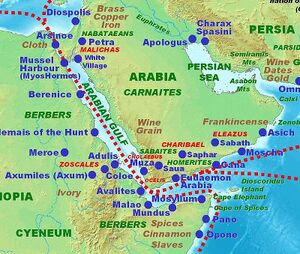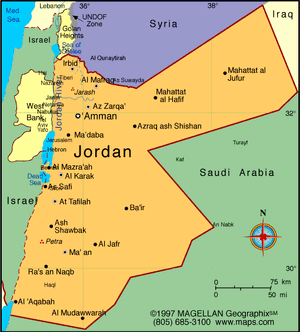Petra
| Author:Laxman Burdak, IFS (R) |


Petra (पेत्रा) is an historic and archaeological city in southern Jordan. Pliny[1] has mentioned Petra as a city of the Nabatæi people. Originally it was known to its inhabitants as Raqmu or Raqēmō.[2][3]
Variants
- Al-Batra
- Raqmu
- Raqēmō/Raqemo
- Arabic: ٱلْبَتْرَاء,
- romanized: Al-Batrāʾ;
- Ancient Greek: Πέτρα, "Rock",
- Nabataean: 𐢛𐢚𐢓𐢈)
- Petra (Pliny.vi.39)
Jat Gotras Namesake
- Petwar = Petra (Pliny.vi.32)
- Batra
Location
Petra is adjacent to the mountain of Jabal Al-Madbah, in a basin surrounded by mountains forming the eastern flank of the Arabah valley running from the Dead Sea to the Gulf of Aqaba.[4]
History
The area around Petra has been inhabited from as early as 7000 BC,[5] and the Nabataeans might have settled in what would become the capital city of their kingdom as early as the 4th century BC.[6] Archaeological work has only discovered evidence of Nabataean presence dating back to the second century BC,[7] by which time Petra had become their capital.[8] The Nabataeans were nomadic Arabs who invested in Petra's proximity to the incense trade routes by establishing it as a major regional trading hub.[9]
The trading business gained the Nabataeans considerable revenue and Petra became the focus of their wealth. The Nabataeans were accustomed to living in the barren deserts, unlike their enemies, and were able to repel attacks by taking advantage of the area's mountainous terrain. They were particularly skillful in harvesting rainwater, agriculture and stone carving. Petra flourished in the 1st century AD, when its Al-Khazneh structure – believed to be the mausoleum of Nabataean king Aretas IV – was constructed, and its population peaked at an estimated 20,000 inhabitants.[10]
Although the Nabataean kingdom became a client state of the Roman Empire in the first century BC, it was only in 106 AD that it lost its independence. Petra fell to the Romans, who annexed Nabataea and renamed it as Arabia Petraea.[11] Petra's importance declined as sea trade routes emerged, and after an earthquake in 363 destroyed many structures. In the Byzantine era several Christian churches were built, but the city continued to decline, and by the early Islamic era it was abandoned except for a handful of nomads. It remained unknown until it was rediscovered in 1812 by Johann Ludwig Burckhardt.[12]
Access to the city is through a 1.2-kilometre-long gorge called the Siq, which leads directly to the Khazneh. Famous for its rock-cut architecture and water conduit system, Petra is also called the "Rose City" because of the colour of the stone from which it is carved.[13]
Importance in antiquity
Pliny the Elder and other writers identify Petra as the capital of the Nabataean Kingdom and the centre of their caravan trade. Enclosed by towering rocks and watered by a perennial stream, Petra not only possessed the advantages of a fortress, but controlled the main commercial routes which passed through it to Gaza in the west, to Bosra and Damascus in the north, to Aqaba and Leuce Come on the Red Sea, and across the desert to the Persian Gulf.[14]
Tourism
It has been a UNESCO World Heritage Site since 1985. UNESCO has described Petra as "one of the most precious cultural properties of man's cultural heritage".[15] In 2007, Al-Khazneh was voted one of the New 7 Wonders of the World.[16] Petra is a symbol of Jordan, as well as Jordan's most-visited tourist attraction.
Mention by Pliny
Pliny[17] mentions Arabia....Next after them are the Nabatæi, who have a city called Petra10, which lies in a deep valley, somewhat less than two miles in width, and surrounded by inaccessible mountains, between which a river flows: it is distant from the city of Gaza, on our shores, six hundred miles, and from the Persian Gulf one hundred and thirty-five. At this place two roads meet, the one leading from Syria to Palmyra, and the other from Gaza.
On leaving Petra we come to the Omani11, who dwell as far as Charax, with their once famous cities which were built by Semiramis, Besannisa and Soractia by name; at the present day they are wildernesses.
10 Mentioned in B. v. c. 21, if, indeed, that is the same Petra.
11 Omana or Omanum was their chief place, a port on the north-east coast of Arabia Felix, a little above the promontory of Syagros, now Ras el Had, on a large gulf of the same name. The name is still preserved in the modern name Oman.
पेत्रा
पेत्रा (अरबी: البتراء, अल-बत्रा; यूनानी: πέτρα; अंग्रेजी: Petra, पेट्रा) जॉर्डन के म'आन प्रान्त में स्थित एक ऐतिहासिक नगरी है जो अपने पत्थर से तराशी गई इमारतों और जलवाहन प्रणाली के लिए प्रसिद्ध है। इसे छठी शताब्दी ईसापूर्व में नबातियों ने अपनी राजधानी के तौर पर स्थापित किया था। माना जाता है कि इसका निर्माण कार्य 1200 ईसा पूर्व के आसपास शुरू हुआ। आधुनिक युग में यह एक मशहूर पर्यटक स्थल है। पेत्रा एक "होर" नामक पहाड़ की ढलान पर बना हुई है और पहाड़ों से घिरी हुई एक द्रोणी में स्थित है। यह पहाड़ मृत सागर से अक़ाबा की खाड़ी तक चलने वाली "वादी अरबा" (وادي عربة) नामक घाटी की पूर्वी सीमा हैं। पेत्रा को युनेस्को द्वारा एक विश्व धरोहर होने का दर्जा मिला हुआ है। बीबीसी ने अपनी "मरने से पहले 40 देखने योग्य स्थान" में पेत्रा को भी शामिल किया हुआ है।
इतिहास: 6 वीं शताब्दी ईसा पूर्व से पेत्रा नाबातियन साम्राज्य की प्रभावशाली राजधानी थी। जिसके बाद इस साम्राज्य का 106 ई° में रोमन साम्राज्य में विलय हो गया था और रोमनों ने शहर का विस्तार जारी रखा। व्यापार और वाणिज्य के लिए एक महत्वपूर्ण केंद्र, पेत्रा ने तब तक विकास जारी रखा जब तक कि एक विनाशकारी भूकंप ने इमारतों को नष्ट नहीं कर दिया और छठी शताब्दी में मुस्लिमों ने पेत्रा को जीत लिया लेकिन यह ज्यादा समय तक मुसलमानों के अधीन नहीं रहा। इसके बाद 1189 ई° में मध्य पूर्व के मुस्लिम सुल्तान सलादिन की विजय के बाद पेत्रा को ईसाइयों ने त्याग दिया।
ट्रांस-जॉर्डन के गठन के बाद इस स्थल की पहली वास्तविक पुरातात्विक खुदाई 1929 ईस्वी में गयी थीं। 1989 में स्टीवन स्पीलबर्ग ने फिल्म इंडियाना जोन्स और लास्ट क्रूसेड का फिल्मांकन इस स्थान पर किया था जिसके कारण यह जॉर्डन के सबसे बड़े पर्यटक आकर्षण बन गया। पेत्रा की शानदार इंजीनियरिंग उपलब्धियों और अच्छी तरह से संरक्षित आयाम के कारण पेत्रा, को पुरातात्विक स्थल जुलाई 2007 में दुनिया के नए सात आश्चर्यों में से एक के रूप में चुना गया।
References
- ↑ Natural History by Pliny Book VI/Chapter 32
- ↑ Stephan G. Schmid and Michel Mouton (2013). Men on the Rocks: The Formation of Nabataean Petra. ISBN 9783832533137.
- ↑ Shaddel, Mehdy (2017-10-01). "Studia Onomastica Coranica: AL-Raqīm, Caput Nabataeae*". Journal of Semitic Studies. 62 (2): 303–318. doi:10.1093/jss/fgx022. ISSN 0022-4480
- ↑ Cooke, George Albert (1911). "Petra". In Chisholm, Hugh (ed.). Encyclopædia Britannica. Vol. 21 (11th ed.). Cambridge University Press. pp. 309–310.
- ↑ "A Short History". Petra National Foundation.
- ↑ Taylor, Jane (2001). Petra and the Lost Kingdom of the Nabataeans. London: I.B.Tauris. pp. 14, 17, 30, 31. ISBN 9781860645082.
- ↑ Mati Milstein. "Petra. The "Lost City" still has secrets to reveal: Thousands of years ago, the now-abandoned city of Petra was thriving". National Geographic.
- ↑ "A Short History". Petra National Foundation.
- ↑ "A Short History". Petra National Foundation.
- ↑ "Petra Lost and Found". National Geographic. 2 January 2016
- ↑ "Petra lost and found". History Magazine. 2018-02-09.
- ↑ Glueck, Grace (17 October 2003). "ART REVIEW; Rose-Red City Carved From the Rock". The New York Times.
- ↑ "Major Attractions: Petra". Jordan Tourism Board.
- ↑ Cooke, George Albert (1911). "Petra". In Chisholm, Hugh (ed.). Encyclopædia Britannica. Vol. 21 (11th ed.). Cambridge University Press. pp. 309–310.
- ↑ "UNESCO advisory body evaluation" (PDF). Archived (PDF) from the original on 2012-01-13.
- ↑ ""Lost City" of Petra Still Has Secrets to Reveal". Science. 2017-01-26.
- ↑ Natural History by Pliny Book VI/Chapter 32

